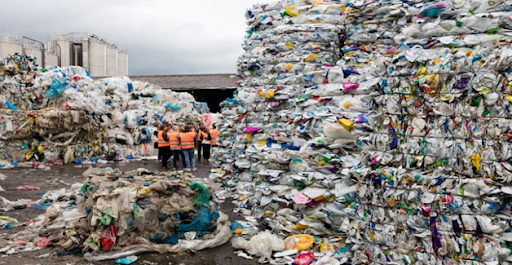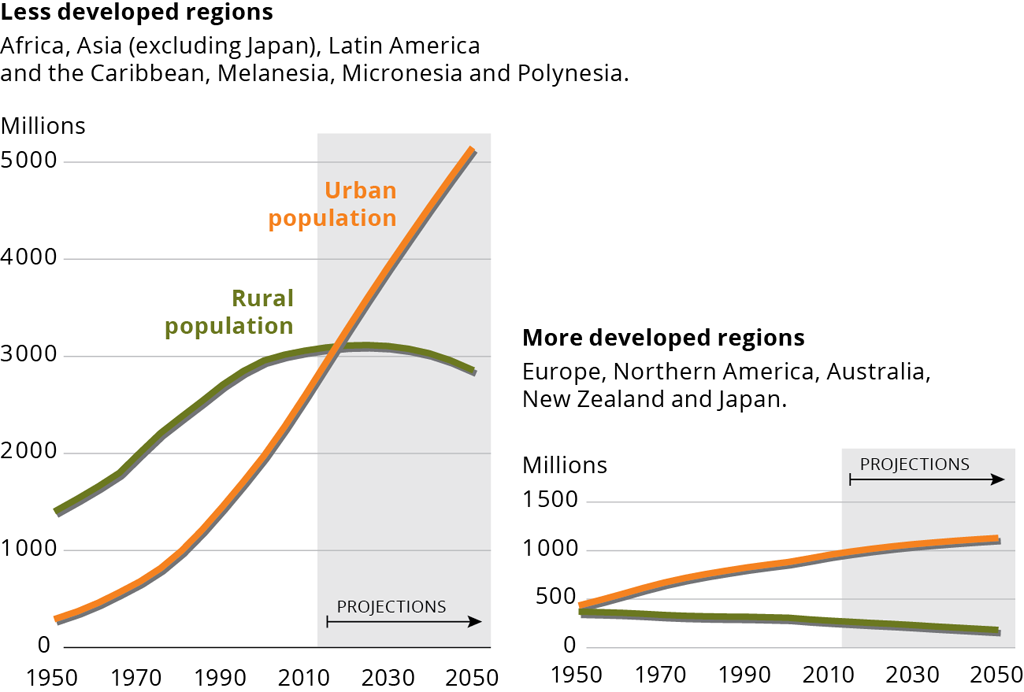Waste Research
Research Beyond the Lab: Open Science and Research Methods for a Global Engineer
2024-04-18
Week 8: Solid Waste Management

Photo: E. Tilley
Course overview
12:15-13:00: Introduction to Waste Management
13:15-14:00: Presentation and Brainstorming with S. Kahlert, ETH Sustainability
14:15-15:00: Research Questions
Introduction to Waste Management
Learning Objectives
- Learners can articulate the scale and drivers of the challenges in solid waste management
- Learners understand the flow of waste from Generation to Recovery
- Learners can identify waste management challenges at ETH and/or Zurich
- Learners can develop their own research questions using either the PICOT or FINER method
World challenges in solid waste are urban

Source: European Environment Agency (EEA)
Challenges of SWM
- Public health
- Environmental health – Local and Global
- Resource value
Special concern when ecological carrying capacity is overburdened
- Population density = risk of exposure
- Waste materials properties = severity of exposure
Health Threats
- Exposure to pollutants: formal and informal workers (collectors, sorters) exposed to waste (also by flooding)
- Proliferation of pests: waste attract insects and rodents that carry diseases
- Respiratory problems due to open burning of garbage
- Physical risks: occupational related risk of injuries

26 dead in the Philippines, 2011
Environmental Threats
- Contamination of water, soil, air…(plastics, metals, toxins, nutrients)
- Blockage of drains -> flooding -> erosion
- Deterioration of aesthetic value of landscapes (tourism)

Source: World Bank Water
Unknown impacts
- Great Pacific Garbage Patch: 0.41 – 8.1% of Pacific Ocean
- Plastic facts: take > 400 years to degrade, bioaccumulation
- More than 80 % from land-based human activities

Source: Haultail
ISWM Framework

Source: samim
3Rs…

Source: LAHS ECO Engineering
…9Rs

Source: Gypsy Soul
Generation
Switzerland has one of the highest municipal solid waste volumes in the world, at 716 kg of waste per person and year. Nearly 53% of it is recycled.

Waste generation versus income level by country, UNEP/ISWA (2015)
Generation

Waste generation versus income level by country, UNEP/ISWA (2015)
Collection and Transport

Source: TMA
Collection and Transport

Source: UNDP
Collection and Transport

Source: UNDP
Treatment

Photo: E. Tilley
Treatment

Photo: E. Tilley
Recovery

Source: ETH Zürich
Recycling

Source: LivingIn
Stakeholders
- Waste generators – Need to interface with the system (waste segregation?)
- Central/provincial government – Determine strategy, policy, regulation, commitments
- Municipality – Service provider and regulator
- NGOs & CBOs – Awareness and self-help initiatives
- Private formal sector – Provide service
- Private informal sector – Play an integral and important part in most low and middle income countries
- Internal & external support agencies – Support and steer through funding and international conventions
Policies
- Regulation and Enforcement
- Social Mobilization
- Inform, education, communicate
- Economic Instruments
- Incentives, fines
Take home messages
- Management of MSW is one of the major challenges worldwide
- The amount of waste generated is often linked directly to income level and lifestyle
- There is no one-size-fits-all solution to the SWM challenge
- The socio-economic, cultural and institutional context requires special consideration of appropriately adapted technologies, capacity building, including improvement of skills and know-how at local government level
- The ISWM framework is a structured assessment method to understand and find solutions to existing SWM systems.
- Recovery of resources (materials and energy) is a promising way to go in solid waste management
Research Questions
Finding the right research question early will save you a lot of headaches later
The research question will influence
- Who or what you sample
- The research design you use (we will discuss Week 9)
- The type of analysis you use
As Dr. Fandino states:
“…up to one third of the time spent in the whole process… [should] be invested in finding the right primary study question”
Compare the examples
- Do supraglottic devices provide similar conditions for the visualization of the glottis aperture in a German hospital?
versus
- Among children younger than 1 year of age undergoing elective minor procedures, to what extent the insertion times are different, comparing the Supreme laryngeal mask airway (LMA) to Proseal LMA, when placed after reaching a BIS index <60?
Let’s examine the first question
Do supraglottic devices provide similar conditions for the visualization of the glottis aperture in a German hospital?
- “Do these devices…provide similar conditions…” implies a YES or NO answer ❌
NEVER ask a yes or no question!
❌ Is the city of Zurich able to recycle all of its plastic?
❌ Does the city of Zurich recycle all of its plastic?
❌ Do people recycle plastic?
✅ What percentage of waste is the city of Zurich able to recycle?
✅ How much does it cost to recycle all of the plastic in Zurich?
✅ Who are the residents most likely to recycle plastic?
To help us define the key components of a Research Question we use the PICOT Framework
- Population
- Intervention
- Comparator
- Outcome
- Timeframe
With many clarifying questions spelled out in the paper. Even when we don’t really understand the research topic, we should be able to identify the components of PICOT
Among children younger than 1 year of age undergoing elective minor procedures, to what extent the insertion times are different, comparing the Supreme laryngeal mask airway (LMA) to Proseal LMA, when placed after reaching a BIS index <60?
- Population: children <1 undergoing elective minor procedures
- Intervention:
- Comparator:
- Outcome:
- Timeframe:
Among children younger than 1 year of age undergoing elective minor procedures, to what extent the insertion times are different, comparing the Supreme laryngeal mask airway (LMA) to Proseal LMA, when placed after reaching a BIS index <60?
- Population: children <1 undergoing elective minor procedures
- Intervention: Supreme LMA
- Comparator:
- Outcome:
- Timeframe:
Among children younger than 1 year of age undergoing elective minor procedures, to what extent the insertion times are different, comparing the Supreme laryngeal mask airway (LMA) to Proseal LMA, when placed after reaching a BIS index <60?
- Population: children <1 undergoing elective minor procedures
- Intervention: Supreme LMA
- Comparator: Proseal LMA
- Outcome:
- Timeframe:
Among children younger than 1 year of age undergoing elective minor procedures, to what extent the insertion times are different, comparing the Supreme laryngeal mask airway (LMA) to Proseal LMA, when placed after reaching a BIS index <60?
- Population: children <1 undergoing elective minor procedures
- Intervention: Supreme LMA
- Comparator: Proseal LMA
- Outcome: times of insertion
- Timeframe:
Among children younger than 1 year of age undergoing elective minor procedures, to what extent the insertion times are different, comparing the Supreme laryngeal mask airway (LMA) to Proseal LMA, when placed after reaching a BIS index <60?
- Population: children <1 undergoing elective minor procedures
- Intervention: Supreme LMA
- Comparator: Proseal LMA
- Outcome: times of insertion
- Timeframe:
“Interventions” are common in medicine, economics, engineering
- What is the impact of extra sleep on student grades?
- What is the impact of a cash payment on the rate of mothers who vaccinate their children against polio?
- What is the impact of a natural dye on the durability of recycled PET?
Not necessary, and ideally avoided in your own project
Your turn! Write out a research question using the PICOT or PCOT method (5 minutes)
We will discuss (15 minutes)
Ok, so we have our research questions which are technically good (we can analyze the data), but is it work asking? To assess whether it’s possible or useful we use the FINER framework:
- Feasible:
- Interesting:
- Novel:
- Ethical:
- Relevant:
Ok, so we have our research questions which are technically good (we can analyze the data), but is it work asking? To assess whether it’s possible or useful we use the FINER framework:
- Feasible: do you have the money to do it? Can you measure your outcome?
- Interesting:
- Novel:
- Ethical:
- Relevant:
Ok, so we have our research questions which are technically good (we can analyze the data), but is it work asking? To assess whether it’s possible or useful we use the FINER framework:
- Feasible: do you have the money to do it? Can you measure your outcome?
- Interesting: does anyone care about this?
- Novel:
- Ethical:
- Relevant:
Ok, so we have our research questions which are technically good (we can analyze the data), but is it work asking? To assess whether it’s possible or useful we use the FINER framework:
- Feasible: do you have the money to do it? Can you measure your outcome?
- Interesting: does anyone care about this?
- Novel: do the results add something new to what we already know?
- Ethical:
- Relevant:
Ok, so we have our research questions which are technically good (we can analyze the data), but is it work asking? To assess whether it’s possible or useful we use the FINER framework:
- Feasible: do you have the money to do it? Can you measure your outcome?
- Interesting: does anyone care about this?
- Novel: do the results add something new to what we already know?
- Ethical: is it safe?
- Relevant:
Ok, so we have our research questions which are technically good (we can analyze the data), but is it work asking? To assess whether it’s possible or useful we use the FINER framework:
- Feasible: do you have the money to do it? Can you measure your outcome?
- Interesting: does anyone care about this?
- Novel: do the results add something new to what we already know?
- Ethical: is it safe?
- Relevant: is it useful?
For your projects, you don’t need to worry too much about whether it is “Novel” but it should be interesting and relevant (either for ETH, ERZ, etc.)
Your turn! Assess your research question using the FINER framework (5 minutes)
Discussion (15 minutes)
